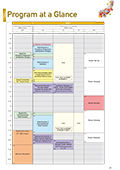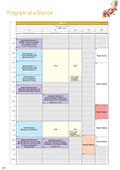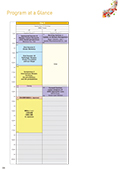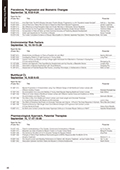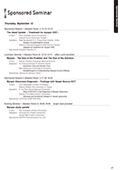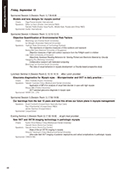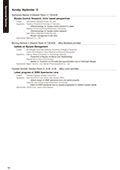- Under the auspices of
- Japanese Association of Pediatric Ophthalmology
- Conference Host
-
Japan Myopia Society
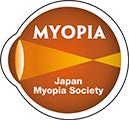 Brien Holden Vision Institute
Brien Holden Vision Institute

- Conference Secretariat
- c/o JTB Communication Design, Inc.
Meeting & Convention Business Unit
JTB Bldg. 7F, 2-1-25 Kyutaromachi,
Chuo-ku, Osaka 541-0056, Japan
Tel: +81-6-4964-8869 Fax: +81-6-4964-8804
E-mail: 17imc@jtbcom.co.jp
Program
At a Glance
Chew Sek-Jin Award Lecture 【Session Room 1】14-Sep 11:20-12:20

- Chairs:
-
Christine Wildsoet
-
Kyoko Ohno-Matsui
- Awardee:
-
Professor Earl L. Smith IIIDean, College of Optometry, University of Houston
- Title of Lecture:
- Do low ambient lighting levels promote the development of myopia in primates?
A variety of observations suggest that low ambient lighting levels could put the eye at risk for developing myopia. We investigated the effects of low ambient lighting on normal refractive development and deprivation- and defocus-induced ametropias in infant monkeys. Specifically, 29 rhesus monkeys were housed under dim ambient lighting (5-36 lux) maintained on a 12 hour lights-on/12 lights-off cycle from 24 to 154 days of age. During the dim light (DL) period, animals were allowed unrestricted vision (n=7) or were reared wearing monocular diffusers (n=7), or either monocular -3D (n=7) or +3D spectacle lenses (n=8). Comparison data were obtained from age-matched control animals that were subjected to the same rearing strategies, but housed under typical laboratory lighting levels (~350 lux). The DL regimen resulted in more variable, but relative hyperopic, ametropias in animals reared with unrestricted vision. DL did not alter the course of form-deprivation myopia; however, it did reduce the likelihood that animals reared with either -3D or +3D of imposed anisometropia would exhibit compensating anisometropic growth. Data from both the treated and fellow-control eyes of lens-reared monkeys suggested that DL diminished the normal response to myopic defocus. Thus, DL appears to reduce the efficiency of emmetropization and, in the case of lens-treated monkeys, the ability of myopic defocus to slow ocular growth. Thus, DL can increase the risk of myopia.
ZEISS Young Investigator Award in Myopia Research 2019 &
Josh Wallman Memorial Lecture
【Session Room 1】12-Sep 10:45-11:45
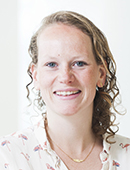
- Chairs:
-
Christine Wildsoet
-
Kyoko Ohno-Matsui
- Awardee:
-
Dr. Virginie J.M. VerhoevenErasmus Medical Center
- Title of Lecture:
-
A Decade of Human Myopia Genetics Research:
Big data, Big questions
The knowledge on the genetic background of refractive error and myopia has expanded dramatically in the past few years. To date, almost 200 genetic loci have been identified for refractive error and myopia, and risk variants mostly carry low risk but are highly prevalent in the general population. Several genes for secondary syndromic myopia overlap with those for common myopia. Polygenic risk scores show overrepresentation of high myopia in the higher deciles of risk. Annotated genes have a wide variety of functions, and all retinal layers appear to be sites of expression. The current genetic findings offer a world of new molecules involved in myopiagenesis. As the missing heritability is still large, further genetic advances including large-scale, in-depth genetic studies using complementary big data analytics, consideration of gene-environment effects by thorough measurement of environmental exposures, and focus on subgroups with extreme phenotypes and high familial occurrence are needed. Functional characterization of associated variants is simultaneously needed to bridge the knowledge gap between sequence variance and consequence for eye growth.
Symposia
Symposium 1
●National Myopia Prevention and Control Policies - An Update
- Chairs:
- Ian Morgan
- (Australian National University)
- Kyoko Ohno-Matsui
- (Tokyo Medical and Dental University)
Introduction. What are the options?
- Ian Morgan
- (Australian National University)
Myopia prevention and control in Taiwan
- Pei-Chang Wu
- (Kaohsiung Chang Gung Memorial Hospital)
Myopia prevention and control in Singapore
- Seang-Mei Saw
- (National University of Singapore)
Progress towards defining a myopia prevention and control strategy for mainland China
- Mingguang He
- (University of Melbourne)
The Strategy for Myopia Control and Prevention in the UK
- Nicola Logan
- (Aston University)
Updates of treatment for Myopic Medical/Surgical Complications
- Yasushi Ikuno
- (Ikuno Eye Center)
Symposium 2
●International Myopia Institute: the possibilities and the probabilities
- Moderators:
- Serge Resnikoff
- (Brien Holden Vision Institute)
- Earl L. Smith III
- (University of Houston)
- Organiser:
- Monica Jong
- (Brien Holden Vision Institute)
- Panelists:
- Daniel I. Flitcroft
- (University Coll. Dublin and Dublin Inst. of Technology)
- David Troilo
- (SUNY Coll. of Optometry, State University of New York)
- Christine F. Wildsoet
- (UC Berkeley)
- Nicola S. Logan
- (Aston University)
- Caroline C. W. Klaver
- (Radboud University Medical Center)
- Kate L. Gifford
- (Queensland University of Technology)
- Jacinto Santodomingo-Rubido
- (Menicon Company Limited)
- Lyle Gray
- (Glasgow Caledonian University)
Paper
Oral 1【Session Room 1】12-Sep 8:15-9:03
●Prevalence, Progression and Biometric Changes
- Chair:
- James Loughman
- (Centre for Eye Research Ireland,
Technological University Dublin)
- Nicola Logan
- (Aston University)
Application of Big-Data for Epidemiological Studies of Refractive Error
- Michael Moore
Potential Value of Centile Analysis in Eye Growth and Refractive Development
- Daniel I. Flitcroft
The Progression of Myopia before the Age of 25 Years: The DREAM Study
- Willem Tideman
Progression and Longitudinal Biometric Changes in Highly Myopic Eyes
- Mingguang He
Oral 2【Session Room 1】12-Sep 9:35-10:35
●Genetics
- Chair:
- Chris Hammond
- (King’s College London)
- Milly Tedja
- (Ophthalmology and Epidemiology,
Erasmus Medical Centre)
Genetic and Parental Factors of Myopia
- Calvin C. P. Pang
Genetic Study of 542,934 Subjects Identifies Novel Genes and Genetic Mechanisms Predisposing to Refractive Error and Myopia
- Christopher Hammond
Improving Prediction of Myopia using Information on Genetic Risk Factors
- Pirro Hysi
Pathway-Specific Genetic Risk Scores Associated with High Myopia
- Milly S. Tedja
Analysis of Genetic Networks Regulating Refractive Eye Development in Collaborative Cross Mice Reveals New Genes and Pathways Underlying Human Myopia
- Andrei V. Tkatchenko
Oral 3【Session Room 1】12-Sep 15:28-17:16
●Environmental Risk Factors
- Chair:
- Seang-Mei Saw
- (Singapore Eye Research Institute)
- Pei-Chang Wu
- (Kaohsiung Chang Gung Memorial Hospital)
A Systematic Review: The Role of Time Exposed to Outdoor Light for Myopia Prevalence and Progression
- Leila S. Eppenberger
Outdoor Play, Playgrounds, and Myopia in Children
- Clair Enthoven
Habitual Indoor and Outdoor Activity of Myopic and Non-Myopic University Students in the United States and Norway
- Elise N. Harb
Comparison of Outdoor Exposure and Nearwork between Children with and without Parents with Myopia by Using Clouclip
- Weizhong Lan
Outdoor Jogging and Myopia Progression in School Children from Rural Beijing: The Beijing Children Eye Study
- Yin Guo
Myopia and Risk Factor Exposures within Academically-streamed Schools
- Amanda N. French
Refractive Error Change among Schoolchildren with 1-Year Tablet Computer Use as Educational Tool in School
- Jung Lo
Recent, but Not Past, Vitamin D Concentrations are Associated with Myopia in Young Adulthood
- Gareth N. Lingham
Sleep Duration and Myopia Progression in a Four-year Follow-up of Chinese Children: The Anyang Childhood Eye Study
- Shi-Fei Wei
Oral 4-1【Session Room 1】13-Sep 8:35-9:50
●Animal Models and Basic Research I
- Chair:
- Frank Schaeffel
- (University of Tübingen)
- Chi-Ho To
- (The Hong Kong Polytechnic University)
Special Lecture: Genetically Modified Animal Models of Myopia
- Terri Young
Reviewing Lens-induced Myopia in C57BL/6 Mice
- Beerend Winkelman
Differential Wavelength Cues are Essential for Emmetropization in Tree Shrews
- Timothy J. Gawne
Effects of Myopic-astigmatic Development on Retinal Functions in Chicken
- Sonal A. Vyas
The Impact of Exposure to Multiple Episodes of Defocus on Chick Eye Growth
- Pauline Kang
Amacrine Cells Expressing nNOS are Sensitive to the Sign of Defocus in the Mammalian Retina
- Sally A. McFadden
Oral 4-2【Session Room 1】13-Sep 9:50-11:14
●Animal Models and Basic Research II
- Chair:
- Timothy Gawne
- (University of Alabama at Birmingham)
- Alexandra Benavente-Perez
- (SUNY College of Optometry)
The Mechanism Study of Dopamine D2 Receptor Involving the Flickering Light Induced Myopia of Guinea Pigs
- Shunmei Ji
Low Dose Atropine Does Not Influence Dopamine Release in Chickens
- Kate Thomson
Atropine Distribution in the Chick Eye: Analysis using Mass Spectrometry and Immunoassays
- Muthana H. Noori
Scleral Hif-1α Knock-down Shifted Refraction toward Hyperopia in Normal Environment but Suppressed Form-deprivation Myopia (FDM) Development in Mice
- Xiangtian Zhou
Changes in Choroidal Thickness and Choroidal Blood Perfusion in Guinea Pig Myopia
- Guoyun Zhang
Decreased Stiffness and Increased Permeability in Sclera of Myopic Mice
- Dillon M. Brown
Two Quantitative High-frequency Ultrasound Methods to Assess Microstructural Changes in Guinea Pig Sclera
- Jonathan Mamou
Oral 5【Session Room 1】13-Sep 11:14 -12:02
●Accommodation/Binocular Vision
- Chair:
- Lisa Ostrin
- (University of Houston College of Optometry)
- Sandra Wagner
- (Eberhard Karls University Tuebingen)
Comparison of Different Techniques to Assess the Near Accommodation Responses
- Ting Wang
Emmetropes and Myopes Differ Little in Their Accommodation Dynamics but Strongly in Their Ciliary Muscle Morphology
- Sandra Wagner
Early Warning Effect of Accommodative Facility in the Occurrence of Myopia in Adolescents
- Xiaoyan Yang
Comparison of Binocular Imbalance in Emmetropic and Myopic Volunteers under a Non-immersive Virtual Reality Platform
- Jin Zeng
Oral 6【Session Room 1】13-Sep 16:05-17:41
●Spectacles and Ortho K
- Chair:
- Toshifumi Mihashi
- (University of Tsukuba)
- Sally McFadden
- (University of Newcastle)
The Effect of Orthokeratology Compression Factor on Ocular Higher-order Aberrations
- Jason K. Lau
Clinical Observation of Effect of Long-term Overnight Wearing of Orthokeratology Lenses on Myopia Progression and Ocular Safety in Adolescents
- Yin Yang
Comparison of Myopia Progression between Children Wearing Three Types of Orthokeratology (Ortho-K) Lenses and Children Wearing Single Vision Glasses
- Yo Nakamura
Comparisons of the Myopia Control Effects of Standard Design and Toric Design Orthokeratology Lenses
- Zhao Chen
Influence of Change to Orthokeratology Induced Treatment Zone Diameter and Pupil Diameter on the Optics of the Cornea
- Paul Gifford
A Pilot Study Comparing CRT Orthokeratology Lenses with Two Different Treatment Zone Sizes
- Maria Liu
Anatomic Factors Contributed to Choroidal Thickening after Orthokeratology: Evidence from Image Binarization of SD-OCT
- Jinyun Jiang
Atropine Combined with Orthokeratology (ACO) in the Treatment of Myopia: Change of Subfoveal Choroidal Thickness (SFChT)
- Wenchen Zhao
Oral 7【Session Room 1】14-Sep 8:10-9:22
●Multifocal CL
- Chair:
- Padmaja Sankaridurg
- (University of New South Wales)
- Pauline Cho
- (The Hong Kong Polytechnic University)
Optical and Neural Contribution in the Peripheral Retina to Myopia Control
- Geunyoung Yoon
Central and Peripheral Visual Quality and Accommodation with Multifocal Contact Lenses
- Linda Lundstrom
Accommodation Response with Multifocal Contact Lenses in Non-presbyopic Subjects
- Martin Loertscher
The Adaptation and Acceptance of Defocus Incorporated Multiple Segments (DIMS) for Chinese Adolescents
- Yiqiu Lu
Measured and Predicted Axial Elongation in the MiSight Clinical Trial
- Paul Chamberlain
Efficacy of Myopia Control Contact Lenses (BHVI Extended Depth of Focus Contact Lens and MiSight) in a Contralateral Study Design
- Padmaja Sankaridurg
Oral 8【Session Room 1】14-Sep 15:23-17:47
●Pharmacological Approach, Potential Therapies and Others
- Chair:
- Ian Morgan
- (Australian National University)
- Zhou Xiangtian
- (Wenzhou Medical University)
Current and Emerging Pharmaceutical Interventions for Myopia
- Kritchai Vutipongsatorn
Myopia Controle for Europeans: Evidence-based Protocol
- Caroline C.W. Klaver
Two-Year Clinical Trial of the Low-concentration Atropine for Myopia Progression (LAMP) Study: 0.05% Atropine Remained the Optimal Concentration for Myopia Control
- Jason C.S. Yam
The Efficacy of 0.01% Atropine Ophthalmic Solution for Controlling the Progression of Childhood Myopia (ATOM-J) - Randomized Controlled Trial
- Osamu Hieda
Efficacy of Low Dose Atropine in Indian Progressive Myopes
- Viswanathan Sivaraman
The Efficacy and Safety of Topical 0.01% Atropine in Controlling Near-work Induced Transient Myopia
- Lei Guo
A Gold Standard for Myopia Control Efficacy: Cumulative Absolute Reduction of Axial Elongation (CARE)
- Mark Bullimore
Consistency of Absolute Myopia Control Treatment Effect Across Age (Or Why Tom Aller Got 80% Treatment Efficacy!)
- Noel A. Brennan
Temporal Considerations in Myopia Control Efficacy
- Jaclyn V. Hernandez
7-methylxanthine (7-mx) for Myopia Control - Five-year Data
- Klaus Trier
MyopiaX: Invisible Myopia Treatment using Visible Light
- Hamed Bahmani
Results with Snyder- Thompson Posterior Scleral Reinforcement in Progressive, High Myopic Children in Hungary
- Noemi Szell
Oral 9【Session Room 1】15-Sep 8:05-8:53
●Ocular Biometry
- Chair:
- Christine Wildsoet
- (University of California, Berkeley)
- Rigmor Baraas
- (University of South-Eastern Norway)
Change of The Refractive Status after Cycloplegia and Its Related Factors in Children Aged 6-12
- Bei Du
Mathematical Estimation of Axial Length using Routine Optometric Data in the Absence of Formal Biometry
- Nabin Paudel
Effect of Chromatic and Monochromatic Aberrations on Detecting the Sign of Defocus in the Periphery
- Petros Papadogiannis
Salivary Melatonin, Sleep and Activity: Myopes Compared to Non-Myopes
- Sarah C. Flanagan
Oral 10【Session Room 1】15-Sep 8:53-10:17
●Pathologic Myopia/Ocular Circulation and Eye Shape
- Chair:
- Yasushi Ikuno
- (Ikuno Eye Center)
- Yuxin Fang
- (Tokyo Medical and Dental University)
Watching Spatially Filtered Movies That Enhance ON or OFF Stimulation Changes Choroidal Thickness
- Frank Schaeffel
Choroidal Thickness in Australian Indigenous Children
- Scott A. Read
Representation of the Fundus Shape using Legendre Polynomial Expansions of RPE Segmentation Data Obtained by the OCT with Auto Alignment Function
- Toshifumi Mihashi
Projections of Myopia-associated Eye Diseases
- Xu Cheng
Retinal Complications in High Myopia in Europeans
- Annechien E.G. Haarman
Comparison of Clinical Features in Highly Myopic Eyes with and without Posterior Staphyloma evaluated with Ultrawide-Field Swept-Source OCT
- Takashi Watanabe
Long-Term Outcomes and Complications of Foveola-nonpeeling/Fovea-sparing Internal Limiting Membrane Surgery of Myopic Traction Maculopathy
- Tzyy-Chang Ho
Poster
Rapid fire Presentations
Sponsored Seminar
* Click to enlarge image
